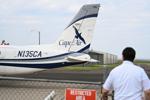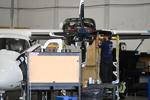First Officer Sam Ben-Eliezer looks out the window of a Cape Air plane bound for Glasgow on Thursday, July 25.
SHUN GRAVES, Billings Gazette
Zach Blackburn and Sam Ben-Eliezer helmed the unpressurized Tecnam P2012 Traveller as it trundled toward an altitude of 9,000 feet, or about 6,000 feet above these high prairies. Not much higher, oxygen thins out even more.
Low fares, high subsidies
This round trip to Glasgow cost $78. Unlike other commercial service out of Billings with fares above the national average, Cape Air prices its subsidized flights well below.
тАЬOur philosophy has always been тАШget the traffic up,тАЩтАЭ said Bill Callahan, Cape AirтАЩs station manager at Billings. тАЬWe want people flying. ThatтАЩs the goal of Essential Air Service.тАЭ
The carrier has held a contract to serve the five cities since 2013.
The federal governmentтАЩs EAS program arose after it deregulated the airline industry in 1978. That meant the nationтАЩs smallest airports lost connections because airlines could not serve them profitably.
Carriers apply through a competitive process with input from the EAS communities. Last year the federal Department of Transportation again selected Massachusetts-based Cape Air for its most recent bid.
тАЬTheyтАЩve done very well,тАЭ said Walt McNutt, chairman of MontanaтАЩs EAS task force. тАЬTheyтАЩve gone through some tough situations, you know, pilot shortages, aircraft problems, whatever. And theyтАЩre limited in their flight altitude, so weather has a big impact on them.тАЭ
Operating costs have grown, and so have subsidies. Across all EAS routes outside Alaska, the federal government pays $493.2 million in annual subsidies to carriers, according to its most recent published report.
In Montana, two other airports receive EAS service, though by SkyWest Airlines. Operating as Delta Connection, it flies from Butte and West Yellowstone to Salt Lake City. And as United Express, it flies from West Yellowstone to Denver.
But Cape Air flies within Montana, eschewing the massive airline hubs to the south. Most people go to Billings anyway, at least from Glasgow. Terrie Arneson, Cape AirтАЩs ground security coordinator at Glasgow, said many fly for medical and dental care.
Eighty percent or more, she estimated.

A Cape Air airplane sits on the apron at Glasgow Valley County Airport on Thursday, July 25.
SHUN GRAVES, Billings Gazette
тАЬTwo of our dentists in town here, theyтАЩre pretty much at retirement,тАЭ she said. тАЬAbout the only two we have. I mean other than that, we donтАЩt really have a lot of dental here either. So I know people fly out for that reason.тАЭ
Small ridership and rising costs have periodically given pause to Washington politicos. However, both of MontanaтАЩs senators have argued in favor of the EAS program.
This year, Cape AirтАЩs twice-daily flights to Glasgow will receive $2.7 million in EAS subsidies. Glendive, Havre and Wolf Point see similar rates. SidneyтАЩs five daily round trips will land $6 million in subsidies. Per the contract, each rate will increase over the next three years.
Four of the five routes have also seen ridership grow.
As of Tuesday, Glasgow, Glendive, Havre and Wolf Point have seen enplanements inch up this year compared to the same time in 2023. Sidney has seen departing passengers dip, according to Cape Air data. But ridership out of Billings has increased.
So far this year, 1,788 people have boarded a Cape Air plane at Glasgow, while 11,144 have climbed on at Billings.
тАЬAt the end of the day, that region works really well for us,тАЭ said Aaron Blinka, Cape AirтАЩs vice president for planning. тАЬIf anything, weтАЩd love to grow the region, if any additional communities are added into the EAS program.тАЭ

The small terminal building at Glasgow Valley County Airport, also known as Wokal Field, is seen on Thursday, July 25. It handles two commercial departures a day.
SHUN GRAVES, Billings Gazette
On time from Glasgow
Like the Fort Peck Lake that riders see on approach, GlasgowтАЩs airport stands out, perhaps because the terminal looks so miniscule by comparison.
тАЬI mainly get private planes, which is our main traffic,тАЭ said Austin Sundeen, the airportтАЩs assistant manager. тАЬBut itтАЩs definitely weird not having many commercial flights, so it keeps it really quiet around here.тАЭ
In preliminary 2023 data from the Federal Aviation Administration, Glasgow saw the fewest passenger enplanements of any U.S. тАЬcommercial serviceтАЭ airport with year-round flights outside Alaska. GlendiveтАЩs airport had fewer passengers, but it belongs to the FAAтАЩs lower тАЬgeneral aviationтАЭ category.
GlasgowтАЩs 2,892 departing passengers had a spartan travel experience few Americans can claim. Here, everything happens one step and one person at a time.
On another recent July morning, the waiting roomтАЩs two rows of chairs faced each other. A couple of vending machines suffice for retail. The Transportation Security Administration checkpoint sat in the corner, closed this early before the flight to Billings.
Passengers walked in occasionally.
Tom McIntyre grew up here and now works for Albertsons corporate in Idaho. He had just attended the grand opening of GlasgowтАЩs newly moved and expanded Albertsons, which included the first Starbucks in 145 miles.
For the first time in years, he flew to Glasgow. McIntyre said he had planned to take the morning flight, but that one got canceled. Bumped to the noon flight, his roundabout connections back to Idaho got longer.
The tiny Glasgow airport still impressed him, McIntyre said after passing through security.
тАЬItтАЩs amazingly sophisticated,тАЭ he added. тАЬI didnтАЩt know they had TSA.тАЭ
Not long before departure, the checkpoint opened. Seven passengers waited. The four security officers led each person through the single lane. Only when one person completed the screening could the next walk up.
A small holding area with nine chairs awaited on the other side.
Then Arneson, of Cape Air, led the passengers toward their ride back to Billings.
One by one, they clambered into the Tecnam. Crouching, they made their way to their assigned spots. McIntyre sat near the front.
тАЬFirst class,тАЭ he said jokingly.
And as the propellers spun and the plane lifted off, GlasgowтАЩs townscape expanded below. Few get to see it from the sky.

A Cape Air mechanic works on a plane at Billings Logan International Airport on Friday, July 26.
SHUN GRAVES, Billings Gazette
Be the first to know
Get local news delivered to your inbox!
Source link : http://www.bing.com/news/apiclick.aspx?ref=FexRss&aid=&tid=66bccac35b244082866836ea2e8bbf75&url=https%3A%2F%2Fbillingsgazette.com%2Fnews%2Fstate-regional%2Fsubsidies-essential-air-service-montana-smallest%2Farticle_7dd72742-59bf-11ef-9bc5-172f7671795e.html&c=6812601921441267802&mkt=en-us
Author :
Publish date : 2024-08-13 20:30:00
Copyright for syndicated content belongs to the linked Source.











